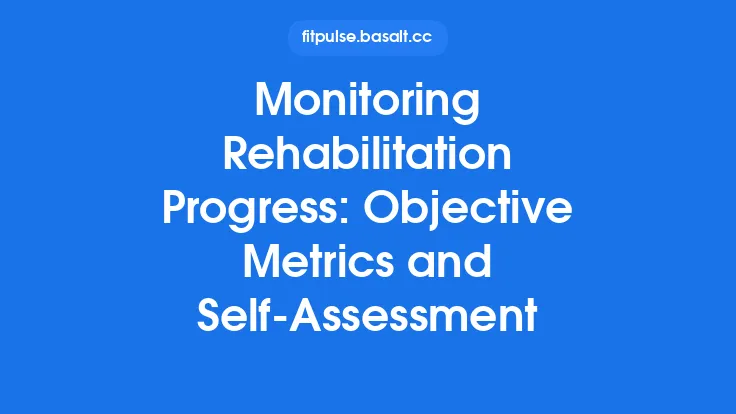The concept of “progressive overload” is often presented as the holy grail of effective training, but the true power of this principle lies not just in adding weight or volume, but in doing so safely. When load increases outpace the body’s ability to adapt, the risk of injury spikes dramatically, and the quality of the training session deteriorates. The same holds true for technique: a flawless movement pattern is the foundation upon which any load‑based progression must be built. This article walks you through the essential components of a safety‑first approach to gradual load increases and systematic technique checks, offering practical tools, evidence‑backed guidelines, and actionable checklists that can be applied across strength, hypertrophy, endurance, and functional training programs.
Why Safety Must Lead the Progression Process
- Biomechanical Integrity – Proper joint alignment and muscle activation patterns protect connective tissue from excessive shear and compressive forces.
- Neuromuscular Adaptation – The nervous system learns to recruit motor units efficiently only when the movement is performed correctly; poor technique hampers this learning curve.
- Long‑Term Consistency – Athletes who experience fewer setbacks stay motivated, leading to higher adherence and better long‑term results.
- Load Management – Incremental load increases that respect tissue healing timelines reduce the incidence of overuse injuries such as tendinopathies and stress fractures.
Core Principles of Gradual Load Increases
| Principle | Practical Guideline | Typical Application |
|---|---|---|
| Small Increment Rule | Increase the external load by 2.5–5 % per week for pure strength work (e.g., 5 kg on a squat for an intermediate lifter). | Linear strength programs, powerlifting cycles |
| Relative Volume Rule | When adding sets or reps, keep the total weekly volume (sets × reps × load) within a 10 % increase. | Hypertrophy‑focused programs |
| Rate of Perceived Exertion (RPE) Buffer | Target an RPE of 7–8 on the final set of a given exercise; if the RPE exceeds 9, hold the load steady or deload. | Autoregulated training, daily undulating periodization |
| Velocity‑Based Thresholds | For barbell lifts, maintain a minimum concentric velocity (e.g., >0.5 m/s for bench press) to ensure the load is still within a safe speed range. | Velocity‑based training (VBT) environments |
| Recovery‑Adjusted Progression | Use a recovery score (sleep quality, HRV, soreness) to decide whether to progress, maintain, or regress the load that week. | Periodized programs with built‑in deload weeks |
Key Takeaway: The safest progression is a controlled progression. Small, quantifiable steps allow the musculoskeletal system to adapt without being overwhelmed.
Structured Technique Checks: When, How, and What to Look For
1. Pre‑Session Warm‑Up & Motor Pattern Activation
- Dynamic Mobility Drills (e.g., hip circles, scapular wall slides) to prime the joints that will bear the load.
- Movement‑Specific Activation (e.g., glute bridges before squats) to ensure the target musculature is “on” before heavy loading.
- Cue Checklist – Write down 2–3 primary cues for the lift (e.g., “Chest up, knees tracking over toes”) and rehearse them mentally.
2. Intra‑Session Form Spotting
| Checkpoint | Timing | What to Observe | Tools |
|---|---|---|---|
| Setup | Before each set | Bar placement, grip width, foot stance | Mirror or video frame |
| Execution | During the lift | Joint angles at key points (e.g., 90° knee depth), bar path, breathing pattern | Coach’s eye, wearable IMU, video playback |
| Recovery | Between sets | Post‑set posture, fatigue signs, movement quality on the next rep | Self‑assessment, RPE scale |
- Cue Reinforcement – If a deviation is noted, pause the set, give a concise cue, and perform a single “technique” rep at a reduced load before resuming.
3. Post‑Session Review
- Video Analysis – Record the last set of each major lift; review at 0.5× speed to spot subtle breakdowns.
- Technique Log – Note any recurring issues (e.g., “knees caving in on squat”) and plan corrective drills for the next session.
- Load‑Technique Correlation – If technique deteriorates at a specific load, consider regressing that load until form stabilizes.
Implementing a Safety‑First Progression Workflow
Below is a step‑by‑step workflow that integrates load progression with technique verification. It can be adapted for both solo training and coached environments.
- Baseline Assessment
- Perform a 1RM or 5RM test with video capture.
- Identify technique deficits and assign corrective drills.
- Program Design
- Choose a progression model (e.g., linear, undulating) that respects the Small Increment Rule.
- Embed deload weeks every 4–6 weeks, or after a 10 % cumulative volume increase.
- Session Planning
- Set load targets based on the weekly progression chart.
- Schedule technique blocks (e.g., first 2 sets at 70 % focusing on form).
- Execution
- Conduct pre‑session checks (mobility, activation).
- Perform intra‑session spot checks after each set.
- Adjust load on the fly using RPE or velocity feedback.
- Post‑Session Review
- Log RPE, velocity, and any technique notes.
- Update the progression spreadsheet: if RPE > 9 or velocity drops > 15 % from target, hold the load for the next week.
- Iterate
- Re‑assess technique every 4 weeks with a mini‑test (e.g., 3‑RM).
- Adjust the increment size based on observed adaptation speed.
Common Pitfalls and How to Avoid Them
| Pitfall | Why It’s Dangerous | Prevention Strategy |
|---|---|---|
| Jumping 10 %+ in load | Exceeds the body’s adaptive capacity, spikes joint stress | Stick to the 2.5–5 % rule; use RPE to gauge readiness |
| Neglecting the “last rep” cue | Allows form breakdown when fatigue sets in | Perform a “technique rep” at 50 % load after the final working set |
| Relying solely on numbers (e.g., always hitting a target weight) | Ignores qualitative aspects of movement | Pair load targets with a technique scorecard (0–5) each session |
| Skipping warm‑up sets | Muscles and CNS are unprepared, increasing injury risk | Include at least 2–3 progressive warm‑up sets before the working load |
| Over‑reliance on ego lifting | Compromises joint alignment for short‑term load gains | Adopt a “quality over quantity” mantra and enforce it with video checks |
Tools and Technologies to Support Safe Progression
- Wearable Inertial Measurement Units (IMUs) – Provide real‑time velocity and bar path data, flagging deviations that may indicate technique breakdown.
- Smart RPE Apps – Allow athletes to log perceived exertion instantly; algorithms can suggest load adjustments for the next session.
- Mirror Systems & Video Apps – Even a simple smartphone on a tripod can serve as a reliable visual feedback tool.
- Force Plates (optional) – Offer insight into ground reaction forces, useful for detecting asymmetries before they become injuries.
- Load‑Tracking Spreadsheets – Color‑code cells based on RPE or technique score (green = good, yellow = caution, red = regress) for quick visual cues.
Sample Weekly Progression Template (Intermediate Strength Program)
| Day | Exercise | Week 1 Load | Week 2 Load | Week 3 Load | Week 4 (Deload) | Technique Focus |
|---|---|---|---|---|---|---|
| Mon | Back Squat | 70 % 5RM (3×5) | 72.5 % (3×5) | 75 % (3×5) | 60 % (2×5) | Depth, knee tracking |
| Wed | Bench Press | 70 % 5RM (3×5) | 72.5 % (3×5) | 75 % (3×5) | 60 % (2×5) | Bar path, scapular retraction |
| Fri | Deadlift | 70 % 5RM (3×5) | 72.5 % (3×5) | 75 % (3×5) | 60 % (2×5) | Hip hinge, spinal neutral |
Notes:
- RPE target: 7–8 on the final set.
- Technique check: After each set, perform a “technique rep” at 50 % load, focusing on the primary cue.
- Deload week: Reduce load to 60 % and cut volume by 30 % to promote recovery.
Building a Culture of Safety in Group or Coaching Settings
- Standardize Cue Language – Consistency reduces confusion and speeds up corrective feedback.
- Educate on Load‑Technique Interdependence – Run short workshops that demonstrate how a 5 % load increase can alter joint angles.
- Encourage Self‑Monitoring – Teach athletes to use a simple “3‑Question Form Check” (1️⃣ Was my spine neutral? 2️⃣ Were my joints aligned? 3️⃣ Did I maintain control throughout the range?).
- Document Progress – Keep a shared log where athletes record load, RPE, and a brief technique rating; review it weekly as a team.
- Reward Consistency, Not Just Maxes – Recognize athletes who maintain flawless technique across progressive loads, reinforcing the safety-first mindset.
Quick Reference Checklist: “Is It Safe to Add More Load?”
- [ ] RPE ≤ 8 on the last working set
- [ ] Velocity within 5 % of target range (if using VBT)
- [ ] No major technique deviations observed in video or by the coach
- [ ] Recovery metrics (sleep, HRV, soreness) are within baseline
- [ ] Warm‑up sets completed with perfect form
- [ ] Load increase does not exceed 5 % (strength) or 10 % (hypertrophy) from the previous week
If any box is unchecked, hold or regress the load and address the underlying issue before progressing.
Final Thoughts
Progressive overload is a powerful engine for improvement, but without a safety net of gradual load increments and rigorous technique verification, it can quickly become a liability. By embedding small, data‑driven load steps, systematic form checks, and recovery‑aware decision making into every training session, you create a resilient framework that protects the athlete’s body while still delivering consistent gains. The principles outlined here are timeless—applicable whether you’re coaching a novice lifter, programming for an elite athlete, or simply striving for personal progress in the gym. Prioritize safety first, and the results will follow.





